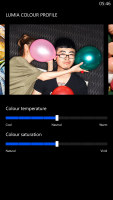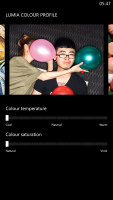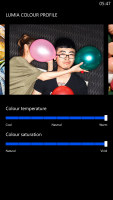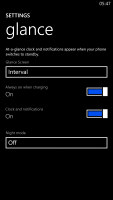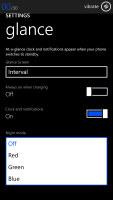Nokia Lumia 1520 preview: Second encounter
Second encounter
Display
The Nokia Lumia 1520 has a 6" IPS LCD screen of 1080p resolution, the pixel density works out to 367ppi. The LCD assembly incorporates Nokia's ClearBlack tech - a set of polarizing filters, which minimize glare. Plus, Gorilla Glass 2 on top for protection.


The 6" IPS LCD on the Lumia 1520
The capacitive touch sensor on the display features the supersensitive touch technology that allows it to detect fingers even through winter gloves.
The 1520 comes with the Lumia Color Profile option in the settings, which gives you two sliders to play with - one for color temperature (which spans the cool, neutral and warm range) and color saturation (natural to vivid).
Nokia Glance screen keeps the clock and notification counters visible even after you lock the screen. This could be set to appear only for a little while after you lock the screen, intermittently on and off and always on. There's a separate always on setting for when the device is charging. A Night mode allows you to pick a different color for the Glance screen info - Red, Green or Blue - if the default White setting is too bright for your sleepy eyes.
One new option in GDR3 is the screen rotation lock. That's an important feature for a phablet, but unfortunately it's only accessible from the Settings menu, which means you have to leave the app you are in to change it, there are no quickly accessible toggles here (this is a common problem for any settings in Windows Phone).
As we already mentioned, the Lumia 1520 screen is tack sharp. Due to its large diagonal, pixel density drops below 400ppi, but 367ppi is still better than what most people's eyes can resolve, especially when you consider you tend to hold a phablet further away from your eyes than a phone.
The viewing angles are pretty good with only a minor shift in contrast when viewed at an extreme angle. Color rendering is good and, as an added bonus, you can tweak the white balance and saturation to your liking. The one weak spot of the display is the black levels, which are not as great as on AMOLED, but the overall contrast is still pretty great.
| Display test | 50% brightness | 100% brightness | ||||
| Black, cd/m2 | White, cd/m2 | Black, cd/m2 | White, cd/m2 | |||
| HTC One Max | 0.14 | 224 | 1591 | 0.40 | 629 | 1572 |
| Samsung Galaxy Note 3 | 0 | 149 | ∞ | 0 | 379 | ∞ |
| Sony Xperia Z1 | - | - | - | 0.38 | 580 | 1513 | Nokia Lumia 1520 | 0.22 | 263 | 1174 | 0.43 | 522 | 1207 |
| Nokia Lumia 1020 | 0 | 172 | ∞ | 0 | 398 | ∞ |
| Nokia Lumia 920 | - | - | - | 0.48 | 513 | 1065 |
| Sony Xperia Z Ultra | - | - | - | 0.47 | 467 | 1001 |
| Sony Xperia Z | - | - | - | 0.70 | 492 | 705 |
| Huawei Ascend Mate | 0.23 | 222 | 982 | 0.67 | 711 | 1053 |
| Samsung Galaxy Mega 6.3 | 0.12 | 160 | 1364 | 0.32 | 440 | 1379 |
| Samsung I9505 Galaxy S4 | 0 | 201 | ∞ | 0 | 404 | ∞ |
| HTC Butterfly S | 0.15 | 165 | 1117 | 0.43 | 451 | 1044 |
The ClearBlack tech does help minimize reflectivity. The relatively low brightness however hurt the outdoor performance.
Sunlight contrast ratio
-
Nokia 808 PureView
4.698 -
Apple iPhone 5
3.997 -
Samsung Galaxy Note 3
3.997 -
Samsung I9300 Galaxy S III
3.419 -
Nokia Lumia 925
3.402 -
Samsung I9505 Galaxy S4
3.352 -
Samsung Omnia W
3.301 -
Samsung Galaxy S
3.155 -
Samsung Galaxy S4 mini
3.127 -
Samsung Galaxy S4 zoom
3.118 -
Nokia N9
3.069 -
Samsung Galaxy Note
2.970 -
Sony Xperia Z1
2.950 -
HTC One S
2.901 -
BlackBerry Q10
2.856 -
Samsung Galaxy S II
2.832 -
Samsung Galaxy S II Plus
2.801 -
BlackBerry Z30
2.790 -
Huawei Ascend P1
2.655 -
Sony Xperia ZR
2.672 -
Nokia Lumia 900
2.562 -
HTC One Max
2.537 -
Nokia Lumia 720
2.512 -
HTC One
2.504 -
Sony Xperia Z
2.462 -
Samsung Galaxy S III mini
2.422 -
Motorola RAZR i
2.366 -
Samsung Galaxy Note II
2.307 -
Apple iPhone 4S
2.269 -
HTC Desire 600 dual sim
2.262 -
LG Nexus 5
2.228 -
HTC One X
2.158 -
Nokia N8
2.144 -
Oppo Find 5
2.088 -
BlackBerry Z10
2.051 -
Apple iPhone 4
2.016 -
HTC One mini
2.003 -
LG G2
1.976 -
Sony Ericsson Xperia ray
1.955 -
Samsung Galaxy Camera
1.938 -
HTC Butterfly
1.873 -
Huawei Ascend P6
1.865 -
Nokia Lumia 1520
1.813 -
Sony Xperia V
1.792 -
Sony Xperia U
1.758 -
Meizu MX3
1.754 -
LG Optimus 4X HD
1.691 -
HTC One V
1.685 -
BlackBerry Q5
1.682 -
LG Optimus Vu
1.680 -
LG Optimus GJ
1.666 -
HTC Desire V
1.646 -
Sony Xperia Z Ultra
1.578 -
Samsung Galaxy Core
1.563 -
LG Optimus G Pro
1.552 -
LG Optimus 3D
1.542 -
Nokia Asha 302
1.537 -
Sony Xperia M
1.473 -
Nokia Lumia 610
1.432 -
Gigabyte GSmart G1355
1.361 -
HTC Desire C
1.300 -
Nokia Asha 501
1.270 -
LG Optimus L7
1.269 -
LG Optimus L9
1.227 -
Meizu MX
1.221 -
Sony Xperia E dual
1.203 -
Samsung Galaxy Pocket
1.180 -
Sony Xperia tipo
1.166 -
Samsung Galaxy mini 2
1.114
Reader comments
- udbhav_garg
- 15 Jan 2015
- u7E
I have been using Lumia phones from the very starting the very original Lumia 800 to Lumia 1520, and in between. I have also,used android phones like note 3. I personally feel that interms of performance Lumia are way ahead of Android phones and the...
- yow
- 22 Oct 2014
- Rbq
Why dont they change their OS? Its actually the os keeping them down from the competition. Windows 8.1 is so boring/annoying especially in the app drawer when scrolling down and up to look for the app. Windowsstore still lagging behind. Doesnt have a...
- mewwww
- 01 Mar 2014
- fuN
Pls,in ur next update,try to make it double or triple SIM..And ensure that u put, in place,all other things that need to be improved on...Nokia is always the best
